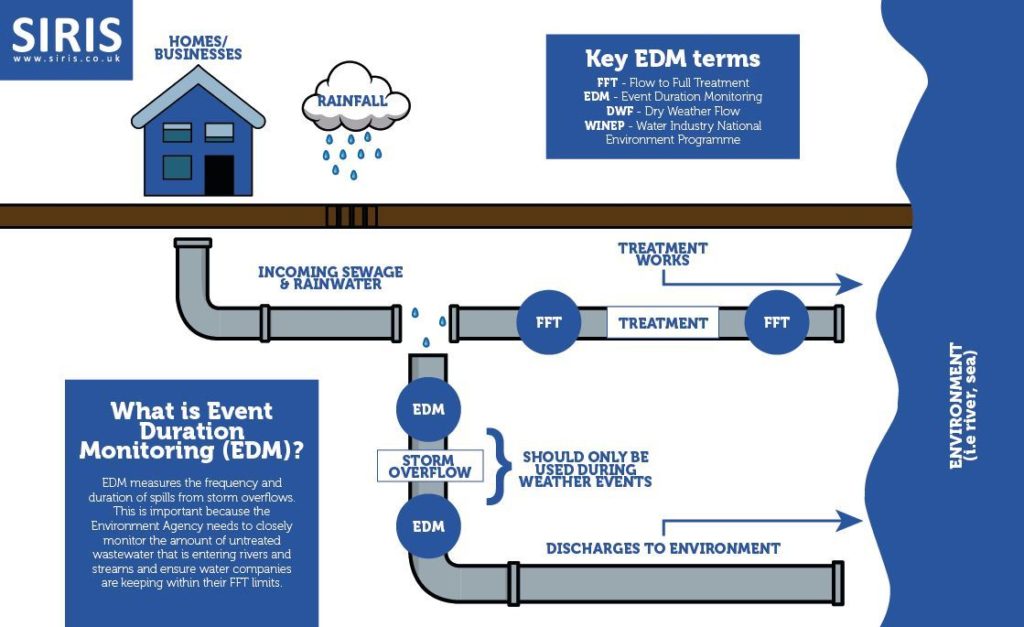LEARN MORE ABOUT:
Event Duration Monitoring 101
+ FREE downloadable EDM infographic!
Event Duration Monitoring (EDM) continues to be a hot topic in the water industry. In this article we’re diving in to the nitty gritty of EDM and explaining what it means for the water industry.
Find out:
- What is EDM?
- Why is everyone talking about it?
- What WINEP is
- What EDM means for FFT and MCERTS
- How we can help
- Plus download our free EDM infographic.
What is Event Duration Monitoring (EDM)?
In order to explain Event Duration Monitoring (EDM), we first need to understand how water treatment works operate. Combined sewers carry wastewater from homes and businesses, however they also collect rainwater which falls onto areas like streets and roofs.
In normal conditions this water travels to a wastewater treatment works to be treated before it is discharged back to rivers and streams.
However, during a weather event (i.e. a storm or extremely heavy rainfall), water companies are permitted to use storm overflows, which are designed to store wastewater until the treatment works has capacity to treat it, or discharge the diluted wastewater back to the water course, known as a “spill”. This is essential, as otherwise untreated water would back up through the sewage system and flood homes and businesses.
EDM data measures the frequency and duration of spills from these storm overflows. This is important because the Environment Agency needs to closely monitor the amount of untreated wastewater that is entering rivers and streams and ensure water companies are keeping within their FFT limits.
Why is everyone talking about EDM?
In many areas the UK’s sewer system is no longer fit for purpose. In many cases sewage treatment works simply weren’t built to treat the volume of flow they now need to accept. This is a result of population increases as well as changes to weather patterns caused by climate change.
In practice, this has resulted in many sewage treatment works relying on storm overflows on a regular basis, instead of just during the storm events they were designed for. If a storm overflow is already full and a period of heavy rainfall occurs, it will not be able to cope with the additional flow and will discharge a higher volume of wastewater to the environment than it would have done if the overflow had been empty to start with.
If this goes unchecked, the UK’s rivers and streams will continue to be polluted with untreated sewage and could have serious consequences for our environment. In recent years the Environment Agency has taken steps to mitigate these risks and force water companies to monitor their use of storm overflows and invest in their infrastructure in order to meet their environmental obligations.
WINEP
The Water Industry National Environment Programme (WINEP) is a programme of actions water companies are required to take to meet their statutory environmental obligations, non-statutory environmental requirements, or delivery against their statutory functions. In short, it’s the steps they need to take to help improve our environment.
The Government has challenged the UK’s water companies to create an industry that:
- “provides resilient, safe, and affordable water supply and wastewater service for today’s users and future generations
- provides a thriving natural environment with increased environmental value, clean rivers and a sustainable eco-system
- consumers trust and delivers an excellent day to day service, support for vulnerable consumers and acts in the long-term interests of society and the environment”
The Environment Agency, Department for Environment, Food & Rural Affairs (DEFRA) and Water Services Regulation Authority (OFWAT) have jointly developed an overarching process for delivering this programme in England.
WINEP aligns with OFWAT’s findings from PR19, its five-year price review and service package. Under PR19 water companies are required to begin monitoring FFT and storm events in order to achieve MCERTS compliance.
These are mentioned under two main drivers:
- U_MON3
Install EDM on WwTW overflows to storm management systems at WwTW and at last in line overflows at sewage pumping stations. - U_MON4
Install MCERTS flow monitoring as close to the overflow as practicable to record FFT at WwTW where the existing DWF MCERTS flow monitoring, or other installed flow monitoring, cannot be readily used to confirm the permitted FFT setting is being complied with when the overflow to the storm management system operates.
What does EDM have to do with FFT?
Flow to full treatment (FFT) is the maximum flow a sewage treatment works can treat. It is calculated by multiplying the dry weather flow (DWF) by three. FFT is important when carrying out EDM because it allows us to cross reference the two numbers for more accurate results.
What does EDM mean for MCERTS?
Under U_MON4, it will be a requirement for MCERTS flow monitoring to be installed to record FFT. We need to incorporate EDM to record this accurately.
Data from EDM is used in conjunction with flow data to identify whether the works is meeting its permit conditions for FFT, so it is important that the EDM data is sufficiently robust to support this assessment.
Infographic
Learn how EDM works
Download our free infographic to understand how Event Duration Monitoring works.

How can SIRIS help?
As with any flow measurement device, EDM needs to be set up and calibrated by a qualified MCERTS inspector to ensure it doesn’t trigger too early or not at all.
For support with installing an FFT or EDM system on your site, please contact our expert installations project team who will be able to offer you advice and support on choosing the right system.